By kind courtesy of Roger Bailey
Reference to Walking Shadow Designs & Waymarking.
Sundials are listed on Google Maps
INTRODUCTION
The time-honoured practice of sundialling might be considered as an old or forgotten practice, yet it is a tradition that has been carried down through Maltese generations.
The sundial is essentially an instrument used to measure time according to the position of the sun. However, the principles of the function of sundials are nowhere near straightforward and require the skills of a true engineer.
They are not precise devices and, according to the month of the year, the time indicated by the shadow created by the gnomon (a thin rod attached to the face of the sundial at a 36 degree angle) may be off by up to 14 minutes.
These intriguing instruments do not only tell you the time of the day, some also reveal the month, which is generally indicated by rudimentary zodiac symbols that are commonly associated to astrology.
Besides the generally symmetrical divisions on the sundial’s face marking the time of day, other divisions indicate the spring and autumn equinoxes as well as the summer and winter solstices.
Depending on their positioning, some sundials may be more difficult to construct than others. The easiest to make are those facing south and record the 24-hour day. Other sundials may be constructed facing east or west. However, these only indicate 12-hour portions of the day.
Sundials can be found in awkward or obscure places and also in public or private areas. The Dominican Priory of St Dominic, in Rabat, for example, has no fewer than five sundials. Hidden away from public view, four are found high on the walls of the cloister and the fifth is exposed on the outer western wall of the priory. The ones found on three sides of the cloister date to 1717 and were made by convent prior and sundial expert Benedetto Castroni.
There are different kinds of sundials: horizontal and diagonal sundials are found on the ground, floors or on pedestals while vertical sundials are integrated into walls.
Although the first sundial was found in ancient Egypt or Babylon and dates back to 1300 BC, the oldest surviving example in the Maltese Islands is found in a residence in Xewkija and dates to 1540.
One of the most sophisticated and accurate sundials in Malta is found at the Archbishop’s Seminary in Tal-Virtù, Rabat. This was made by Fr George Fenech in 1984, an engineer and avid maker of sundials. Several of his works can be found across the country.
Malta possesses some unique sundial examples. A large horizontal one is found at the Mosta Technopark and the Maritime Museum, in Vittoriosa, has a hand-held sundial that doubles up as a compass.
Sundial at Our Lady of Mellieha Sanctuary
Quick Description: A sundial is carved into the stone on a south facing wall of the Sanctuary of Our Lady of Mellieha, Malta. The sundial is above the aches in the right hand corner.
The sundial at the Sanctuary of Our Lady is a minor feature unnoticed by most visitors. The dial faces south and is engraved in stone, with hour lines in black from 7 am to 5pm. The date and designer of the original dial are unknown. The dial was restored by Fr George Fenech in 1970.
The Sanctuary of Our Lady of Mellieha, Malta is a special place.
Sundial Type: Vertical – Wall mounted dial plate
Sundial at Parish Office, Mellieha
Quick Description: There are the hour lines for an afternoon sundial on the south facing wall of the parish office in Mellieha, Malta
This is an attractive sundial but it lacks a gnomon.
Sundial Type: Vertical – Wall mounted dial plate
Sundial on Old University, Valletta
Quick Description: A sundial dated 1695 is on the south east wall of the old Jesuit University in Valletta Malta
One of the prominent old buildings in Valletta is the Old University founded by the Jesuits. One of the demonstrations of their scientific knowledge is the sundial facing St Paul Street, high on the south wall declining 30 degrees east. The dial shows hour lines from 5 am to 3 pm. The date indications include the ends of the hour lines indicate the solstice limits and a slanted equatorial line. It is prominently dated, 13 August 1695.
The Latin motto reads “TEMPUS ERIT QUANDO CESSABIT TEMPUS ERITQUE LUX AETERNA BONIS NOX SINE FINE MALIS” or “There will be a time when time will cease and there will be eternal light for the good and endless night for the wicked.”
Unfortunately the sundial has been neglected. A dark stain from a rain spout obscures the right side and a brushy weed is growing in a chink between the stones.
This dial is in need of some simple maintenance, weeding and cleaning.
Signs of the Jesuit history remain. Directly across St Paul Street from the sundial is Xavier House and a statue of St Francis Xavier, founder of the Jesuit Order still occupies the niche on Merchant Street, the north west corner of the building.
Sundial Type: Vertical – Wall mounted dial plate
Sundials in the Dominican Priory, Rabat
Quick Description: In the Dominican Priory, Our Lady of the Grotto, Rabat, Malta, are five historical sundials dating from 1717. The sundials are on the walls of the terrace above the terrace above the cloister one facing east, two facing south and one facing west. One dial is on an outside wall facing east.
The sundials were designed by “Castronius”, Fr. Benedict del Castronius, a Sicilian monk and mathematician, He was Prior in 1717 and 1718 when he designed the sundials. He was taught mathematics at the University of Palermo, Sicily and wrote books on mathematics and navigation.
The afternoon dial facing south 102° west is a simple dial with an equatorial line and hour lines for 7 pm to 12noon. A point gnomon curving downward seems incorrect. The lines in the bottom corners marked 1 and 12 are actually the lines for 1:30 and 1 pm. Noon cannot show on this north west facing sundial. The size is 2.51 m x 3.22 m. The motto is SINE SOLE SILEO Latin for “Without the sun, I am silent. A Gemini zodiac symbol is in the centre perhaps marking the summer solstice declination line formed by the ends of the hour lines. The dial seems to be shifted to include the 12 line at the expense of the winter afternoon lines. The dial was repainted in 1915, 1962 and 1992 and needs it again. Paint on the porous limestone exposed to rain and sun does not last long. GPS 52.577 N, 014 23.980 E.
The south facing dial declines about 12° to the west. The gnomon is polar and short to include declination lines, the equinox line is drawn and the solstices indicated by the lengths of the hour lines. Zodiac symbols are shown, Gemini for the summer solstice and both Aries and Libra for the equinox. Size is 4.27 m x 2.80 m. Painted by Fr Castronius in 1717 and repainted in 1915, 1965 and 1992. GPS 35 52.595 N, 014 23.973 No motto.
Beside the south facing dial is a Meridian Noon Mark. This shows the vertical noon line marked off by the months and Zodiac symbols. The meridian was designed and painted by Fr Gulia Calcedonius, a Capuchin Priest in 1812. This was repainted in 1965 and 1992. Below the painted area is a cleared area indicating that an earlier dial here had a longer gnomon.
The morning sundial on the east facing wall has a polar gnomon almost parallel to the wall. This shows morning hours from 4 am to 12 noon. An equinoctial line is marked with the zodiac symbol. This was painted in 1717 and repainted in 1915 and 1965. GPS 35 52.588 N, 14 23.957 E.
We were then led to an outside terrace to see the final sundial, again an east facing dial showing morning hours. This dial has a point gnomon so the hour lines look very different compared to the dial on the inner parallel wall. The equinoctial line is the same as the previous dial. This was originally painted by Fr Castronius in 1717 but remade by Fr Gulia Calcedonius in 1824.
Sundial Type: Vertical – Wall mounted dial plate
The East facing dial on the outer wall.
This dial is the inside east facing morning dial with a polar gnomon
The lines are correctly placed on this dial but the times given seem to be wrong for 1 pm and 12. These look like 1:30 and 1 pm.
The bent gnomon is also now incorrect.
Sundial at Augustinian Priory, Rabat Gozo
Quick Description: The historic sundial above the cloister of the Augustinian Priory (Convent) in Rabat (Victoria) Gozo has been recently restored. This dial is similar to the sundials in the Dominican Priory in Rabat, Malta.
The Augustinian Priory dedicated to St Augustine in Rabat (Victoria) on the island of Gozo has a historical sundial similar to the sundials in the larger Dominican Priory in Rabat, Malta. The references on “Maltese Sundials” including Paul Micallef’s 1994 book and Sir Christopher Daniels article in “Antique Clocks” indicated the sundial to be in poor condition. This is no longer the case as the sundial has been restored within the last 10 years and is in excellent condition. Perhaps Paul Micallef had a hand in this restoration.
The sundial is on the south facing wall of the terrace around the cloister of the Priory. It is a very simple and stark design, just showing the hourly time lines. The declination is a bit east of south and there seems to be a longitude correction built in as the meridian is not vertical.
The surviving records show the priory existed since the 1550’s. Earlier records were destroyed by the attacks by the Ottoman Moslems in 1551 when Gozo was sacked and over 1000 people taken as slaves. We do not know the date the original sundial was painted but it was probably before 1850.
Sundial Type: Vertical – Wall mounted dial plate
St Sebastian Church, Qormi
Quick Description: On St Sebastian Church in Qormi there is a vertical sundials designed in 1978 by Fr. George Fenech, a priest from Qormi.
This was the first of several modern sundials designed by George Fenech. The large vertical features an analemma noon mark and lines showing the longitude correction at noon. The declination lines have the zodiac symbols.
The motto in Maltese is a quotation from Psalm 35.8, “God created the sun to rule over the day”.
George Fenech was a remarkable man, starting as an electrical fitter in the dockyards of Malta at the end of WWI, later qualifying as an electrical engineer. As an engineer, he worked on the electrification of Malta with 3 phase 50 cycle power. He studied further and became Professor of Mathematics at the University of Malta. After he retired, he studied in Rome to become a priest in 1966. In his spare time he designed complex sundials involving analemma noon marks and hour lines.
Sundial Type: Vertical – Wall mounted dial plate
Casino Maltese Meridian Sundial in Valletta
Quick Description: On the main street of Valletta, Fr. George Fenech placed a meridian noon mark sundial.
In Republic Street on the facade of the old Treasury of the Knights of Malta, now the Casino Maltese, Fr. George Fenech placed a meridian sundial to mark the time of noon. The dates are shown as zodiac symbols. The longitude correction is noted as are times just before and after noon.
This location is just across the street from the Library and the statue of Queen Victoria.
Sundial Type: Vertical – Wall mounted dial plate
Fenech Sundial in Triq Anici Qormi
Quick Description: George Fenech designed a sundial with analemma hour lines in 1984 for his neighbour in Qormi, Malta.
Fr. George Fenech, besides being an electrical engineer, professor of mathematics, a sundial designer and a priest, was an amateur astronomer. He had an observatory on top of his home in Qormi. In 1984 he designed a sundial for his neighbour across the street, Triq Anici, the retired Parliamentary Secretary, Dr. George Hyzler.
This sundial features analemma hour lines to correct for the Equation of Time. This was one of the first sundials to have analemma hour lines following the publication of an article by Jerald Walker in the Amateur Scientist section of Scientific American in Dec 1980 on sundials that show clock time. George Fenech’s dial also has the longitude correction and declination lines.
In his book “Sundials: History, Theory and Practice” René Rohr show a picture of a sundial in a convent at Cimiez-sur-Nice by Fr. Ildéphonse in 1876 with analemmic hour lines much like Fr. Fenech’s a century later.
Sundial Type: Vertical – Wall mounted dial plate
Sundial at Archbishop’s Seminary, Rabat
Quick Description: At the Archbishop’s Seminary Rabat, Malta, Fr. George Fenech painted a sundial with analemma hour lines in 1984.
This sundial was first painted but now it is engraved in stone. Perhaps not to be effaced as quickly as the painted sundials. This dial was designed during the rectorship of Mgr Lawrence Gatt during the time of Archbishop Guzeppi Mercieca.
Mr Frans Micallef helped Fr George Fenech to paint the sundial in 1984.
The wall declines slightly west and a longitude correction is included along with the equation of time correction in the analemma shaped hour lines.
The motto is based on Psalm 32.6 “For this cause everyone who is godly shall pray to You, In a time when You may be found.”
Sundial Type: Vertical – Wall mounted dial plate
Pace Sundial at Villa Santa Rosa, Swieqi
Quick Description: Alexei Pace created a sundial on the south facing wall of a residence in Swieqi, Malta in 1997
Alexei Pace’s first public sundial is on the south facing wall of a residence called Villa Santa Rosa in Swieqi. It is a fine vertical declining sundial showing the solstice declination lines and hour lines for daylight savings time. It is signed “A Pace” and dated “1997”. Now Alexei Pace is a successful architect and officer of the Malta Astronomical Society.
Sundial Type: Vertical – Wall mounted dial plate
Zammit Sundial, Dingli Rd, Rabat
Quick Description: On a south facing wall of a house on Dingli Rd, Rabat, Charles G Zammit engraved a sundial dedicated to San Mark in 1933
Charles G Zammit retired from Government Service as Director of Museums and designed several sundials. One is this morning dial declining east of south. It is a large, impressive sundial, 2 m high x 2.5 m wide.
Sundial Type: Vertical – Wall mounted dial plate
Sundial at Technology Park, Mosta
Quick Description: On a circular platform in a square in the centre of the Mosta Technology Park is a large horizontal sundial.
Most sundials in Malta are vertical. This horizontal sundial was designed by Prof Frank Ventura, of Malta University, Author of the book L-Astronomija f’Malta and several papers on the orientation of the temples on Malta.
The sundial is raised about 20” above grade level and is about 15 ft in diameter. The simple design within an ellipse has declination lines for the solstices and equinox, a noon analemma and a small longitude correction. The equinox line is not the same in the morning and afternoon and the analemma meridian does not touch both solstice lines.
Sundial Type: Vertical – Wall mounted dial plate
Sundial in Santa Maria Estates, Mellieha
Quick Description: On a residence on Dahlet is-Sardinell, Santa Maria Estates, Mellieha is a south facing vertical sundial.
The Santa Maria Estates is an upscale area with many attractive residences, many with ocean views. At the end of a cul de sac, Dahlet Is- Sardinell is a residence with a simple but attractive sundial. The hour lines are laid out in half a circle about 1 meter in diameter, recessed into the stone wall. Unfortunately this produces two vertical planes and the gnomon is built for the recessed plane, not the plane of the hour numerals. Even looking straight onto the dial, the two planes give conflicting hour readings. The dial seemed off by half an hour when visited at 4:30 pm. A longitude correction seems to be included as the 12 line is not vertical under the gnomon. This sundial is noted in the book “Maltese Sundials” by Paul Micallef, published in 1994. The dial, designed by a German architect, was constructed a few years before. Since then the house has been stuccoed but the original stone is exposed at the sundial.
On reflection the design is quite flawed. The hour lines are too close together near noon for this latitude. The gnomon angle is too vertical for this latitude. A polar gnomon angle with the horizontal should be equal the latitude or less for a declining sundial. The dial looks good but is seriously flawed. Fashion trumps function again.
Sundial at Stella Maris College
Students at Stella Maris College in Gżira no longer have an excuse for being late for lessons.
In June 2013, the world’s largest human sundial was laid out in their school yard and, just by standing on the meridian line in the middle, they are able to tell the time by the length of their shadow.
Commisioned by Stella Maris College, this is the first ever Sundial made by using Volcanic stone. It measures 7 meters by 4.5 meters and is fully functional. It was made by Mediterranean Ceramics Ltd.

Sundial at Gharb Gozo
Quick Description: This is the only human sundial in the Maltese Islands. It’s situated at the main square in front of the Għarb Parish Church in Gozo. One has just to step on the month and the shadow shows the time.
it was made in 2012 as part of the Pjazza Zjara Tal-Madonna embellishment.

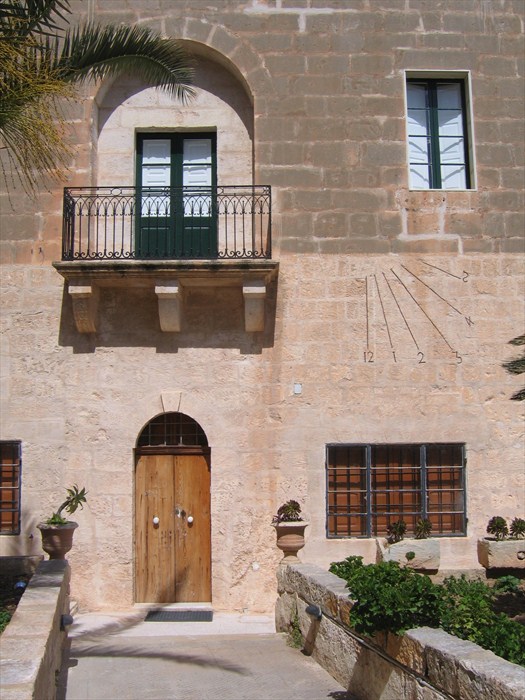
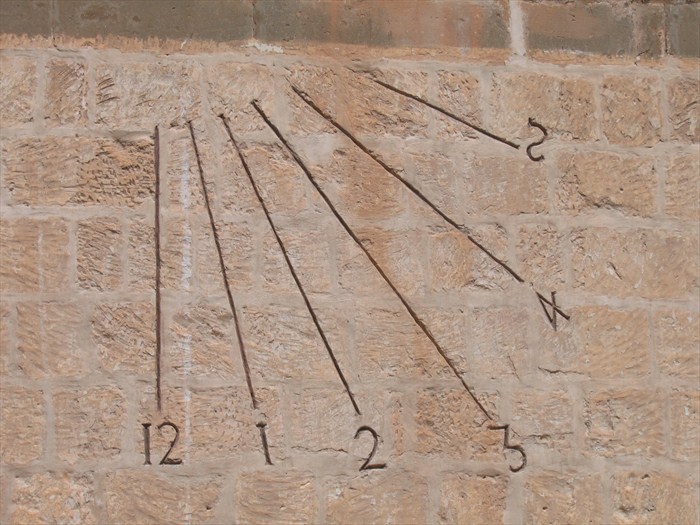
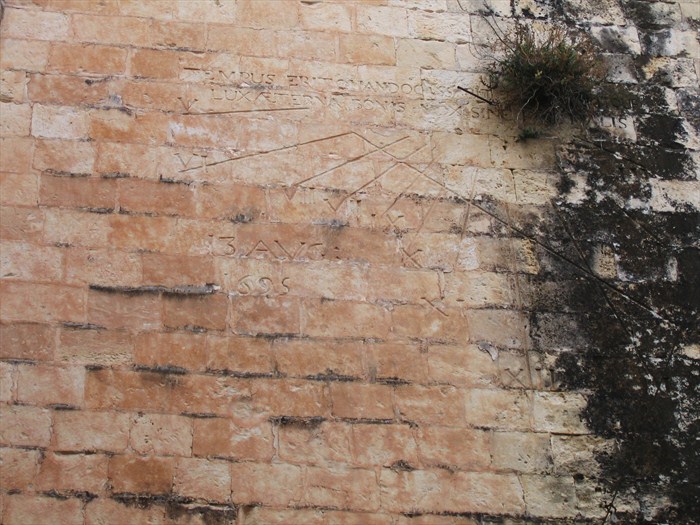
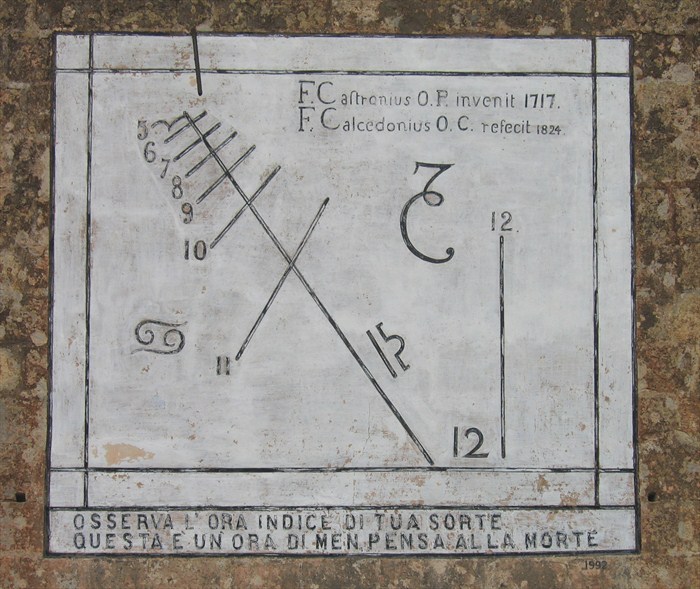
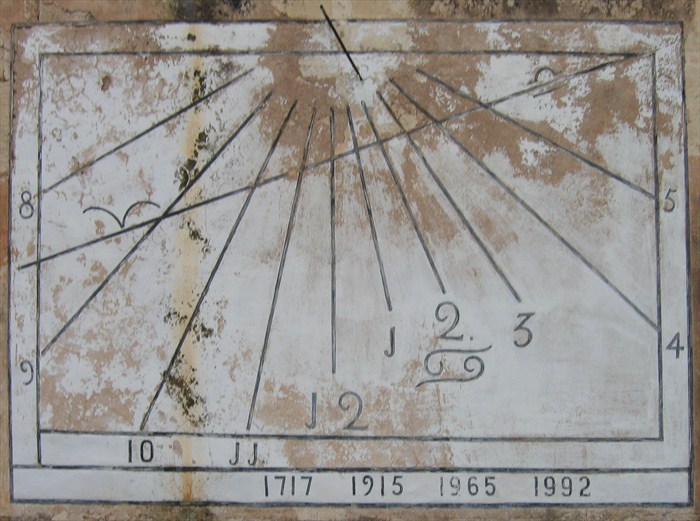
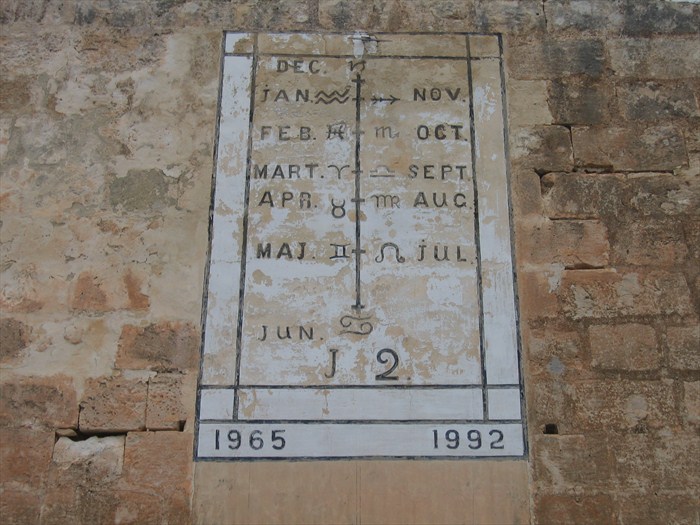


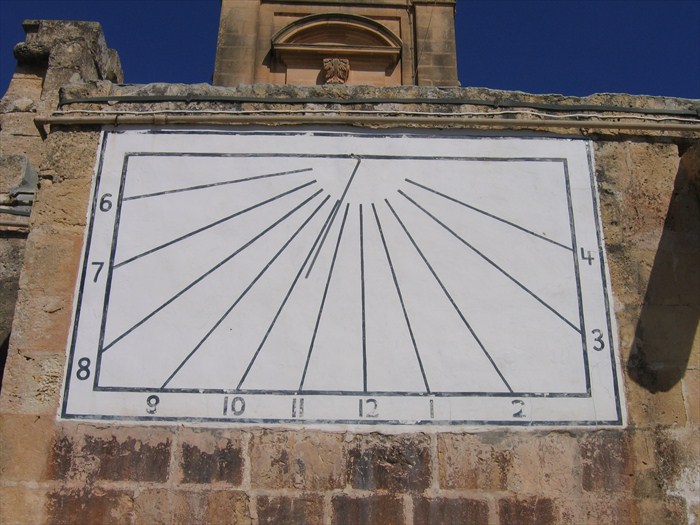
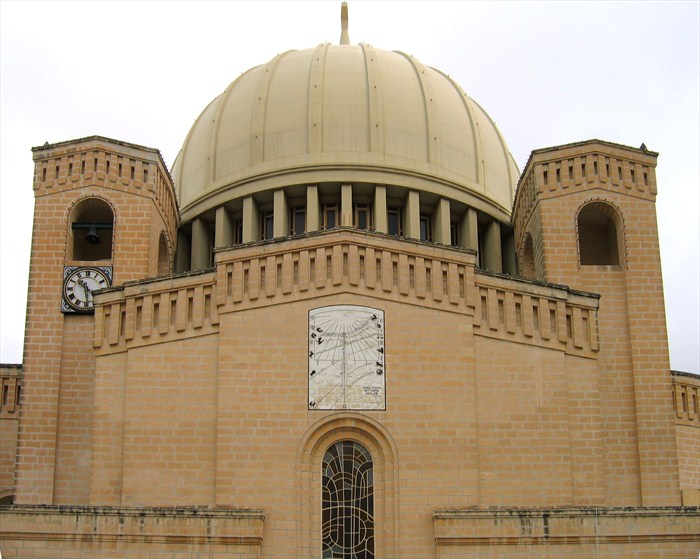
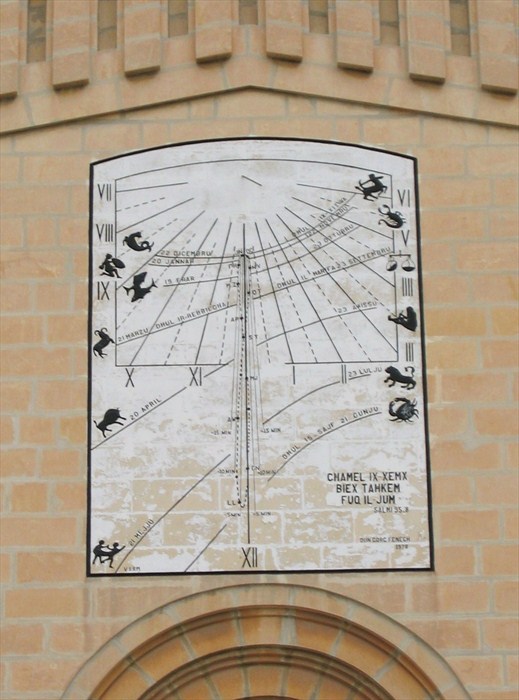
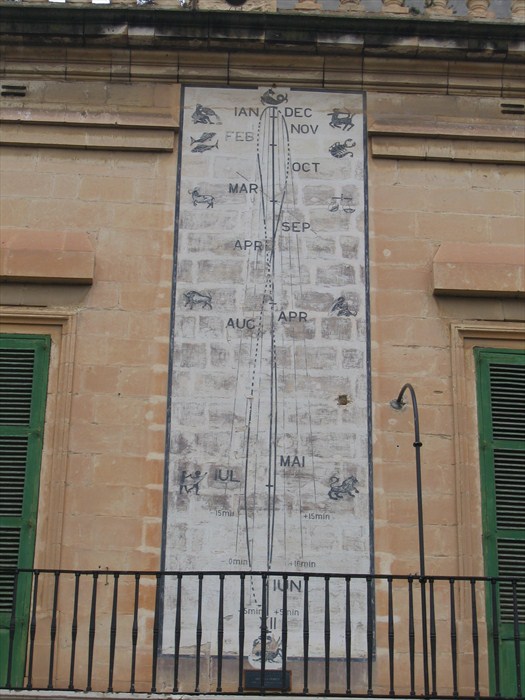
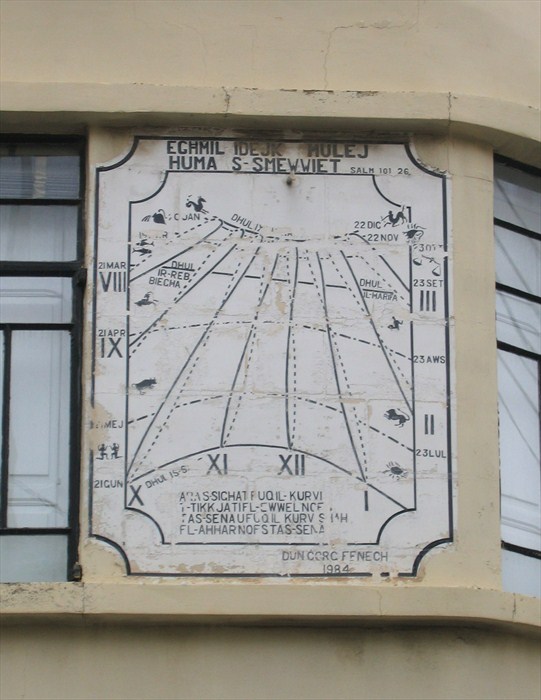
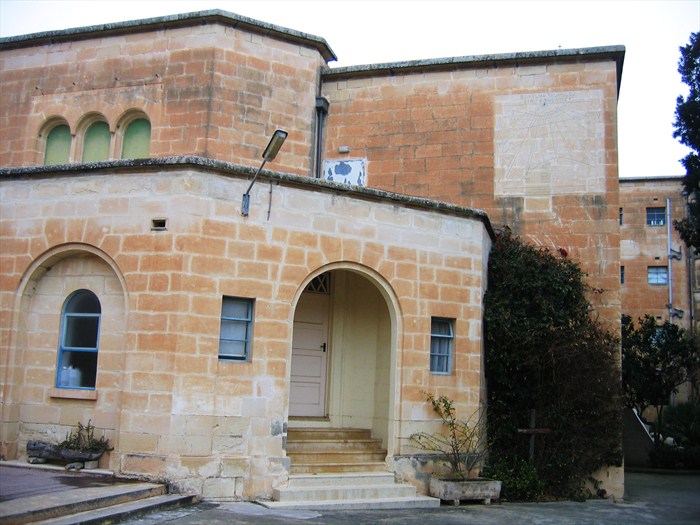
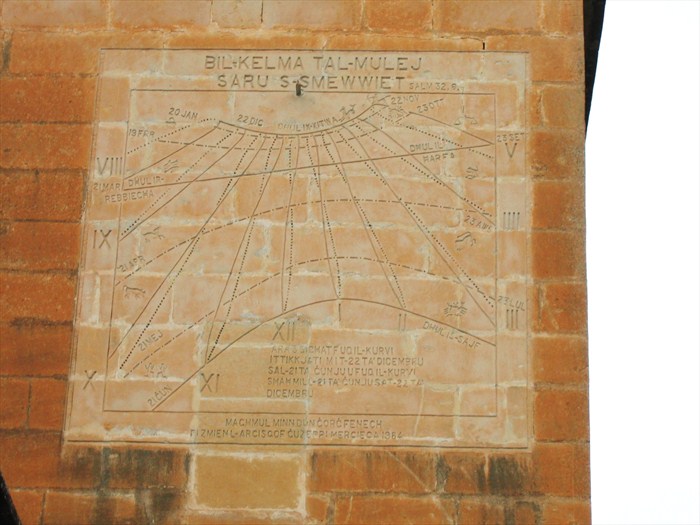

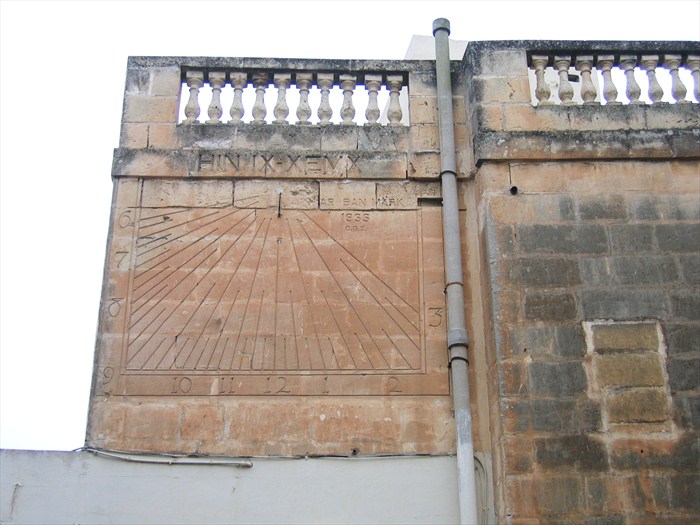
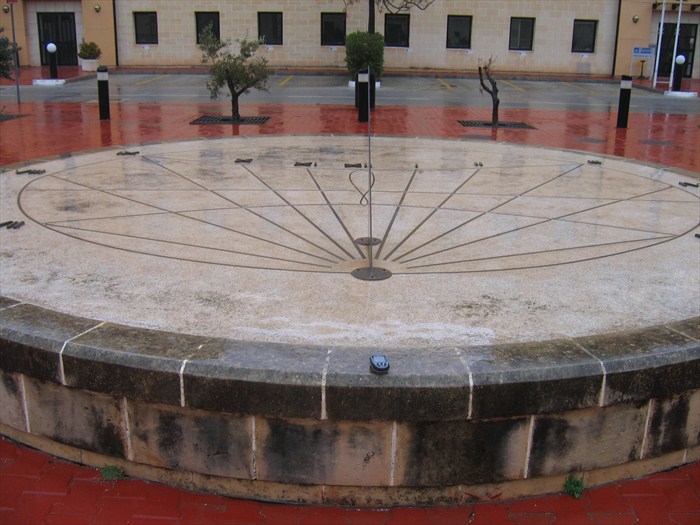
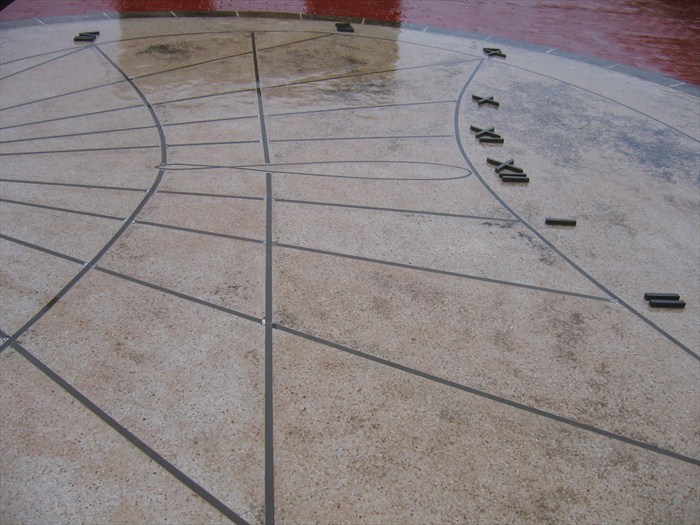
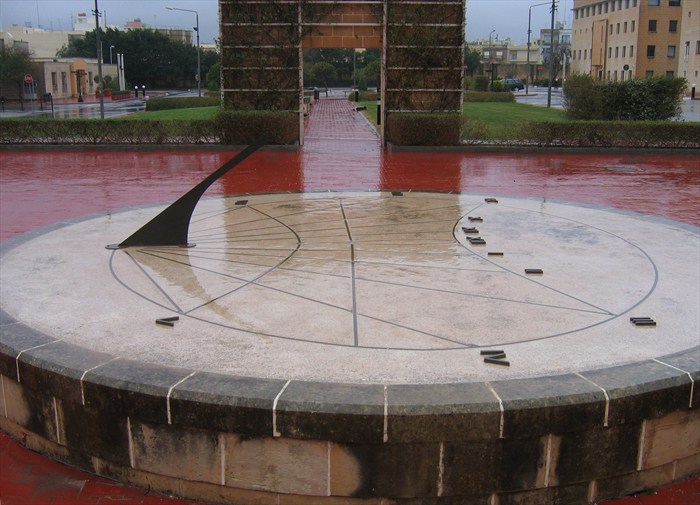
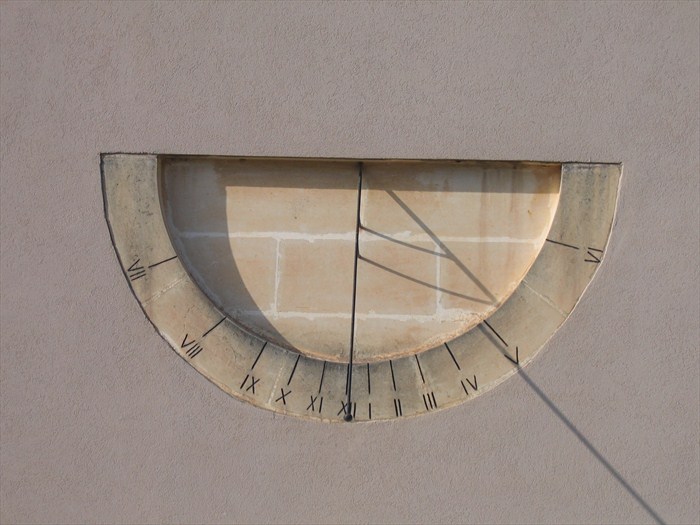
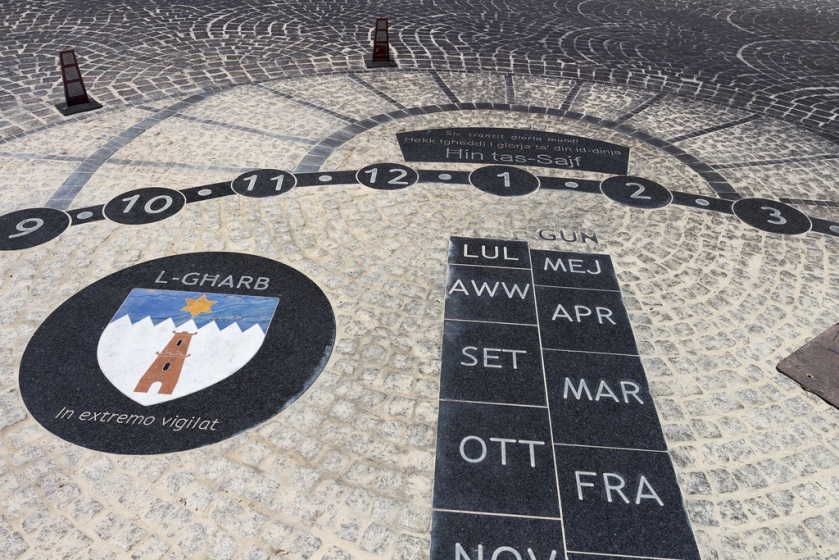
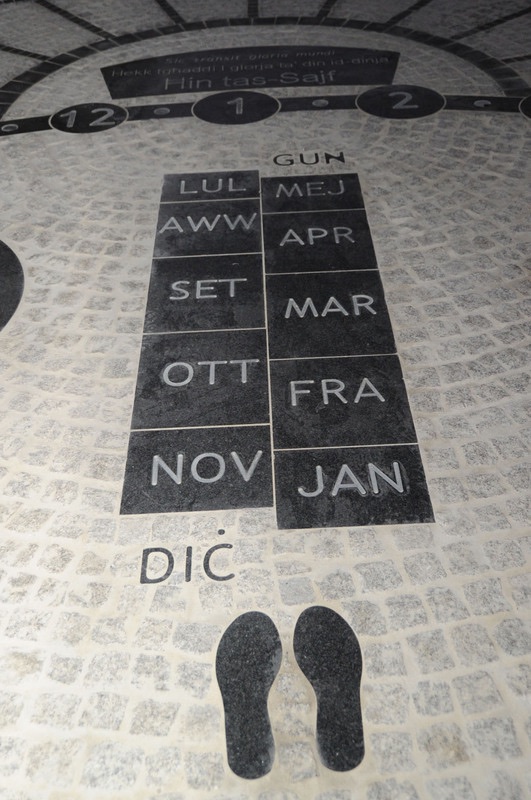
informative but too long thougggghhhh
As usual, very interesting reads…what is missing is how to exactly set up a sun dial! I’ve been searching for this information for quite some time but never was successful! Any idea please?
I have a beautiful reproduction of what I believe to be the one in Xewkija that dates to 1540 which I had bought a long time ago from Gozo. I would love to set it up but have no idea how!
How to Set up a Sundial
Instructions
1. Sundials are only exactly accurate at the latitudes for which they were designed. In other words, a sundial built in Malta will not accurately gauge the time in London. You will need to compensate for this later.
2. Set your sundial in a sunny area, away from trees. Small saplings also count, Over the years, this sapling will grow and thrive and it will block the sun in the process.
3. Set your sundial so that your gnomon points directly north, using a small compass. Compasses, of course, point to magnetic north, so sticklers for accuracy may want to adjust their sundial accordingly to true north, using a magnetic declination map. You can also site your sundial, at exactly noon, local time, so that it also reads the time as exactly noon.
4. Adjust your sundial’s base so that it matches your latitude. A sundial built for 37ºN, but used at 51ºN, will have to be wedged up by 14º. Use a protractor to ensure that your gnomon’s angle to the horizontal matches your latitude. Alternatively, you can site along the line of the gnomen at night, until it points directly at the North Star.
utterly fascinating!